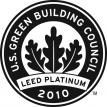SIPs Gain Market Share in Construction Downturn
FOR IMMEDIATE RELEASE
May 28, 2009
Gig Harbor, WA – Despite a multi-year housing slump, structural insulated panels (SIPs) experienced a significant gain in market share in 2008, according to an annual survey conducted by the Structural Insulated Panel Association (SIPA). SIPs are a panelized building system used for wall and roof construction in energy-efficient and green buildings. They are composed of insulating foam sandwiched between two structural facings, typically made of oriented strand board (OSB), although metal and other materials are also used.
With 53.3 million sq. ft. of SIPs produced in 2008, SIPs now command slightly over 1 percent of the U.S. single-family housing market, doubling their market share from the height of the housing bubble in 2005. These gains came amidst an overall 8.8 percent decrease in OSB-faced SIP production, the first recorded decrease since the survey was initiated in 2003.
“With the U.S. economic recession and three straight years of falling housing starts, industry contraction is somewhat inevitable,” said Bill Wachtler, Executive Director of SIPA. “However, the SIP industry has experienced only a moderate decline in comparison to the overall housing market and other building products.”
Wachtler attributes much of the industry’s relative success to the growing popularity of green building. Homeowners are demanding green homes that use less energy, are constructed using fewer natural resources, and provide a healthy indoor environment. Building with SIPs helps homeowners meet these goals, as well as the requirements of green building rating systems such as the U.S. Green Building Council’s LEED for Homes program and the National Green Building Standard.
In addition to the residential market, the survey estimates that more than 1,500 nonresidential buildings were constructed with SIPs in 2008. Nonresidential construction accounted for 32 percent of SIP production, compared to 40 percent for residential construction. Non-building applications such as industrial refrigeration facilities accounted for the remaining 28 percent.
Several different combinations of materials are used to construct SIPs, but the basic concept remains the same. The most popular facing materials are OSB and metal. Plywood and other materials such as fiber cement board accounted for only 7 percent of SIPs used in building applications.
According to Wachtler, SIPA analysts have refined their reporting mechanisms to more accurately account for non-building applications and nonstructural metal-faced products. Using these improved methods, industry growth for 2007 has been revised to a more modest 3 percent. This growth came despite a nearly 30 percent decrease in single-family housing starts in 2007. In 2008, total SIP production fell 11 percent to just over 53 million sq. ft., staying well above the pace of single-family housing starts, which dropped 40 percent.
“Like all industries we are affected by the recession and the drop in new construction,” said Wachtler. “But the strong market share gains we’ve experienced in the last two years indicate that the SIP industry is likely to see a significant increase in production as the economy recovers.”
The survey also polled SIP manufacturers regarding their geographic distribution. The top ranking regions for SIP use were the Mountain, Pacific, South Atlantic, and West North Central regions. Shipments to the South Atlantic region (Florida through Virginia) experienced a significant increase in 2008.
For more information on structural insulated panels, visit www.sips.org.

